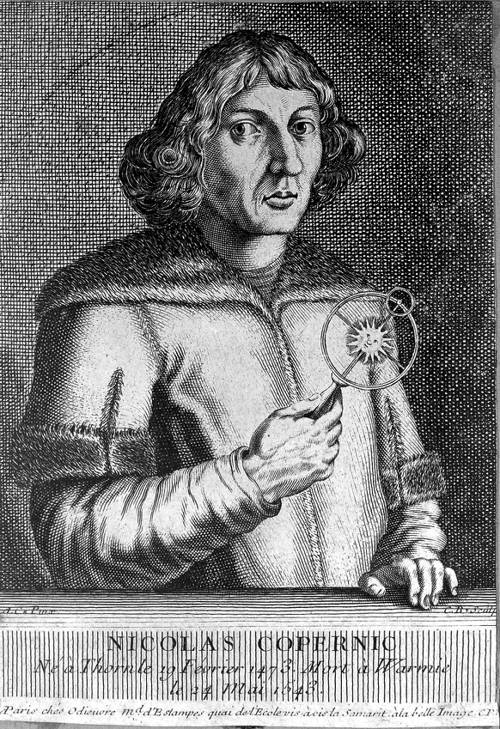
FAQ About Nicolaus Copernicus

Who was Nicolaus Copernicus?
Nicolaus Copernicus was a Renaissance-era polymath who is best known for his pioneering work in astronomy. He formulated a comprehensive heliocentric model of the universe, which placed the Sun, rather than the Earth, at the center of the solar system. This revolutionary idea laid the groundwork for the scientific revolution. Copernicus was also a mathematician, physician, and scholar with interests in various fields, including economics and astrology.

What is the heliocentric model proposed by Copernicus?
The heliocentric model proposed by Nicolaus Copernicus is a theory of the structure of the solar system which posits that the Sun is stationary at the center, with the Earth and other planets orbiting around it. This was a significant shift from the geocentric model, which placed Earth at the center of the universe. Copernicus detailed his model in his 1543 publication, De revolutionibus orbium coelestium (On the Revolutions of the Celestial Spheres).

Why was Copernicus's heliocentric theory significant?
Copernicus's heliocentric theory was significant because it fundamentally challenged the prevailing geocentric model endorsed by the Catholic Church and ancient scholars like Aristotle and Ptolemy. By positioning the Sun at the center, it offered a simpler explanation for the observed motions of celestial bodies. This model set the stage for future astronomers like Galileo Galilei and Johannes Kepler to build upon, eventually leading to a better understanding of the cosmos.

What book did Nicolaus Copernicus publish his heliocentric theory in?
Nicolaus Copernicus published his heliocentric theory in the book titled De revolutionibus orbium coelestium (On the Revolutions of the Celestial Spheres), which was released in 1543, just before Copernicus's death. This seminal work outlined his arguments for the heliocentric model and included extensive mathematical support for his theories.

How did the Church initially react to Copernicus's heliocentric model?
The initial reaction of the Catholic Church to Copernicus's heliocentric model was relatively muted. Because his ideas were seen as mathematical hypotheses rather than claims of physical reality, they were not immediately condemned. However, as the heliocentric theory gained more supporters and the implications for biblical interpretation became clearer, the Church began to oppose its teachings, especially during the time of Galileo.

Who were some other scientists influenced by Copernicus's work?
Several key figures were influenced by Nicolaus Copernicus's heliocentric model, including Johannes Kepler, who formulated the laws of planetary motion; Galileo Galilei, who provided observational evidence supporting heliocentrism; and Isaac Newton, whose law of universal gravitation explained the forces acting within the heliocentric system. These scientists further advanced Copernicus's ideas, contributing significantly to the Scientific Revolution.

Where was Nicolaus Copernicus born?
Nicolaus Copernicus was born on February 19, 1473, in the city of Toruń, which at the time was part of the Kingdom of Poland. Today, Toruń is in modern-day Poland, and it is renowned as a UNESCO World Heritage Site due in part to its association with Copernicus.

What did Copernicus do besides astronomy?
In addition to his groundbreaking work in astronomy, Nicolaus Copernicus was a multifaceted scholar. He practiced medicine, served as a diplomat, and worked as a governor and tax collector. He also wrote about economics, particularly monetary reform, and contributed to mathematical and scientific discussions in fields such as cartography and geometry.

How did Copernicus's work influence the Scientific Revolution?
Copernicus's heliocentric model played a crucial role in ushering in the Scientific Revolution by challenging the established geocentric view of the cosmos. His work inspired a new wave of scientific inquiry and critical thinking that led to groundbreaking advancements in astronomy, physics, and other sciences. By proposing a model based on observation and mathematics rather than doctrine, Copernicus exemplified the spirit of the Scientific Revolution.

What were the main components of Copernicus's heliocentric system?
The main components of Copernicus's heliocentric system included the Sun at the center of the universe with planets, including Earth, orbiting around it in circular paths. The model also accounted for the retrograde motion of planets by suggesting that these apparent backward movements were due to the relative positions and motions of Earth and other planets. This model simplified the complex geocentric view while better explaining observed celestial phenomena.

What challenges did Copernicus face in developing his heliocentric model?
Nicolaus Copernicus faced several challenges while developing his heliocentric model. Firstly, it was a radical departure from the widely accepted geocentric model endorsed by the Church and institutional authorities. He also had to rely on limited observational tools and data to make his calculations. Additionally, there was a reluctance to accept a model that contradicted the long-held beliefs and teachings of influential ancient philosophers such as Aristotle and Ptolemy.

What is the significance of Copernicus's book 'De revolutionibus orbium coelestium'?
De revolutionibus orbium coelestium (On the Revolutions of the Celestial Spheres) is significant because it laid out the first complete theory of heliocentrism, fundamentally challenging the geocentric model that had dominated scientific thought for centuries. The publication not only presented a new basis for astronomy but also enabled other scientists to further develop this model, ultimately revolutionizing our understanding of the cosmos.

Was Copernicus the first to propose a heliocentric model?
While Nicolaus Copernicus is credited with developing the first comprehensive heliocentric model, the idea of a Sun-centered universe existed before him. Ancient Greek philosopher Aristarchus of Samos had also suggested a heliocentric view, but his model was not widely accepted or developed. Copernicus's model was more detailed and mathematically robust, which allowed it to gain traction during the Renaissance.

What methods did Copernicus use to support his heliocentric theory?
Copernicus used mathematical calculations and geometric models to support his heliocentric theory. He intensely studied astronomical observations and leveraged available data from previous astronomers. His method involved careful analysis and comparisons of planetary movements and sought to explain these through a Sun-centered system, which he demonstrated through detailed charts and diagrams in his book, De revolutionibus orbium coelestium.

How did Copernicus's model explain retrograde motion?
Copernicus's model explained retrograde motion—the apparent backward movement of planets—by proposing that it was an optical illusion resulting from the relative position and speed of Earth and other planets. As Earth overtakes another planet in its orbit, the planet appears to move backward against the backdrop of the stars. This contradicted the geocentric explanation, which required complicated epicycles to account for such motions.

What education did Copernicus have to develop his model?
Nicolaus Copernicus received a well-rounded education that contributed to his development of the heliocentric model. He studied liberal arts at the University of Krakow, focusing heavily on mathematics and astronomy. Copernicus later continued his studies in Italy at the Universities of Bologna, Padua, and Ferrara, delving into subjects such as law and medicine, while maintaining an enduring interest in astronomy among other disciplines.

How did Copernicus influence later models of the solar system?
Copernicus's heliocentric model was crucial in influencing later models of the solar system. It set a foundation for future astronomers like Galileo Galilei, who supported the model with telescopic observations, and Johannes Kepler, who refined it with his laws of planetary motion. These developments laid the groundwork for Isaac Newton's theory of gravity, which provided a comprehensive explanation for the solar system's dynamics.

Did Copernicus live to see his theory widely accepted?
Nicaulus Copernicus did not live to see his theory widely accepted. His heliocentric model was published in De revolutionibus orbium coelestium in 1543, shortly before his death. It took several decades, through the work and advocacy of later astronomers such as Galileo and Kepler, before the heliocentric model became broadly accepted in the scientific community.

Was Copernicus purely a theorist or did he conduct observations?
Nicolaus Copernicus was not only a theorist but also engaged in astronomical observations. Though the observational tools at his disposal were rudimentary by modern standards, he used these to gather celestial data, which, combined with his mathematical expertise, enabled him to formulate the heliocentric model. His work was largely theoretical, but grounded in observations and detailed mathematical analysis.

When did the Catholic Church officially accept the heliocentric model?
The Catholic Church gradually accepted the heliocentric model much later after the initial controversies. Official acceptance became more pronounced after Isaac Newton's work unified the motions of celestial bodies with the laws of physics. It wasn't until the 19th century that the heliocentric theory was officially removed from the Church's Index of Forbidden Books, signaling wider acceptance within the Church establishment.
